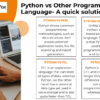E-learning, specifically UAF eLearning, is leading the way in the revolutionary transformation of education in today’s age of fast change. When problems arise with established educational paradigms, UAF eLearning shows up as a flexible answer that not only fixes current problems but also leads education into the future.
The Development of Online Education E-Learning
Increased Accessibility: The unmatched accessibility of eLearning is one of its main benefits. With just one click, students from a variety of backgrounds may now access instructional resources. People who would not have been able to attend traditional educational settings are given chances and barriers are removed through the democratization of education E-Learning process.
Flexibility for Learners: An essential component of eLearning is flexibility. The flexibility to select the time and location of their education allows students to fit different schedules and lives. This adaptability benefits a broader population, including working professionals, parents, and individuals in specific circumstances, and encourages a culture of lifelong learning.
Cost-Effectiveness: Traditional education sometimes comes with a hefty price tag, from tuition to textbooks. However, these expenses are greatly decreased with eLearning. Students no longer have to spend a lot of money on their education because there are so many accessible, reasonably priced, and free online courses.
Technological Developments in Online Education
Virtual reality (VR) education: The integration of virtual reality (VR) into eLearning is revolutionizing students’ educational experiences. Consider a biology course where students may examine the human body in three dimensions, or a history class where students can virtually visit historical civilizations. Virtual reality (VR) increases the immersion and interest in studying by making things come to life.
Artificial Intelligence Applications: AI is essential to customizing the educational process. Intelligent algorithms assess each student’s progress and modify the program to suit their requirements. This guarantees that every student receives customized education, enhancing their comprehension and memory of the subject matter.
Gamification Techniques: Gamification adds a playful edge to online learning. Teachers can increase engagement and motivation by adding components of a game, such badges, levels, and points. This promotes healthy competition among pupils and adds enjoyment to the learning process.
Personalization in eLearning
Adaptive Learning Platforms: Using data analytics, adaptive learning platforms customize course materials to meet the needs of individual students. By focusing on areas where they need to develop, this individualized method guarantees that learners maximize their learning process and get superior results.
Tailored Content Delivery: eLearning makes it possible to distribute material in a variety of forms to accommodate different learning preferences. Teachers may select the most efficient way to provide content, from interactive simulations to podcasts and movies. This adaptability makes sure that students get the material in a way that makes sense to them.
Challenges in eLearning
Technological Barriers: Technology makes eLearning possible, but it also has drawbacks. For some students, obstacles may include having access to digital literacy, appropriate equipment, and high-speed internet. To ensure that everyone has equitable access to high-quality education, these issues must be resolved.
Absence Of In-Person Communication
In-person interactions between instructors and students are crucial to the effectiveness of conventional education. One may feel alone in an online learning environment when there is no physical presence. To meet this issue, creative means of promoting virtual communities and cooperative learning must be found.
Ensuring Engagement: In an online setting, keeping students engaged calls for innovative approaches. Engaging learners through interactive components, real-world applications of information, and conversations can assist maintain their active participation in their education.
Overcoming Challenges: Innovative Solutions
Integration of Interactive Elements: To boost student engagement, e-learning systems use interactive elements like quizzes, virtual labs, and simulations. Learning becomes more relevant and interesting when real-world scenarios are modeled in practical exercises.
Community Building in Online Courses: In eLearning, fostering a feeling of community is essential. Platforms are progressively including features like discussion boards, group projects, and live virtual sessions to foster a collaborative learning environment. The educational process is improved when there is a sense of community among students and teachers.
E-learning’s Effect on Conventional Education
Blending In-Class and Online Learning: The best aspects of traditional classroom instruction are blended with the greatest components of online learning to create the hybrid educational route of the future. This hybrid strategy preserves the essential elements of in-person encounters while optimizing the advantages of technology.
Shifting Educator Roles: Teachers become guides and facilitators through UAF e-learning. Instructors put more of an emphasis on supporting students during the learning process, encouraging critical thinking, and leading them through it than on giving lectures.
Global Reach of eLearning
Breaking Geographical Barriers: Despite geographical restrictions, learners from all over the world may collaborate and communicate via eLearning. This global reach promotes different perspectives and cross-cultural exchange, which improves education overall.
Cultural Considerations in eLearning: Cultural subtleties must be taken into account as education becomes increasingly globally integrated. Lesson designs and instructional practices on e-learning platforms need to be adjusted to ensure cultural sensitivity and relevance.
Future e-Learning Trends
Microlearning: The practice of providing knowledge in manageable portions is known as microlearning. This method fits with the present attention span, so pupils may readily process knowledge. Future trends indicate that microlearning will become more common as a useful and interesting teaching strategy.
Augmented Reality’s (AR) Applications: Through digital overlays, augmented reality (AR) improves the actual environment and offers interactive, realistic experiences. AR in education may be used to construct simulations for hands-on learning, examine virtual creatures, and bring historical events to life.
Role of Educators in the eLearning Era
Training for Online Teaching: To keep up with the ever changing eLearning market, educators require training. Professional development programs may provide them the know-how to use technology efficiently, interact with pupils in virtual environments, and traverse online platforms.
Shifting Pedagogical Approaches: The era of e-learning forces a change in pedagogy. Teachers need to investigate cutting-edge teaching strategies that complement online learning settings and prioritize teamwork, critical thinking, and problem-solving abilities.
e-Learning Platforms: A Comparative Analysis
Popular Platforms and Their Features: Diverse eLearning systems are designed to meet distinct demands. By contrasting well-known platforms like as Coursera, edX, and Khan Academy, educators and learners may choose which is the greatest fit for their requirements and preferences.
Reviews and Suggestions from Users: User feedback from the real world offers insightful information about the advantages and disadvantages of eLearning systems. Making an informed choice while choosing an online learning platform is ensured by taking user ratings and suggestions into account.
Security and Privacy Concerns in eLearning
Data Protection Measures: Because eLearning is digital, privacy and data security are issues. Protecting sensitive data requires effective safeguards like encryption, secure login procedures, and frequent audits.
Ensuring a Secure Learning Environment: Creating a secure learning environment requires not only protecting data but also establishing a safe space for students to express themselves. A secure and motivating online learning environment is facilitated by robust community rules and anti-bullying regulations.
Case Studies: Successful eLearning Implementations
Real-World Examples: Analyzing successful e-learning deployments yields important information on efficient tactics and industry best practices. Studies of organizations or businesses that have successfully used eLearning might provide motivation for others.
Learning from Success Stories: Success story analysis aids in identifying critical components of successful e-learning. Knowing what works in eLearning may help direct future development and implementation efforts, be they university courses or business training programs.
Prospects and Difficulties for the Future
Evolving Technologies: Technology is evolving at a rapid rate, with both possibilities and problems for eLearning. Ensuring that eLearning is fresh, current, and capable of fulfilling learners’ ever-changing demands requires staying abreast of technical changes.
Continuous Improvement in eLearning: A dedication to ongoing enhancement is essential for the long-term prosperity of e-learning. An adaptable and responsive eLearning environment is facilitated by frequent assessments, feedback loops, and upgrades based on new developments in education.
Also Read: Challenges Faced By International Students and Solutions
Conclusion
In summary, eLearning is a revolution that is changing the face of education, not merely a technical advancement. Digital education has endless potential, as seen by the future of eLearning, which includes individualized learning experiences and worldwide cooperation. It’s evident that the future of education is emerging before our own eyes, with eLearning at its forefront, as we negotiate the difficulties and seize the opportunities.
FAQs
Is online education appropriate for all age groups?
Of course! Learners of all ages who want to continue their education can benefit from e-learning, even adults.
How can teachers guarantee that students are engaged in an online setting?
Maintaining student involvement may be achieved through the use of varied instructional techniques, virtual communities, and interactive components.
What part will technology play in schooling going forward?
Innovation in educational approaches, worldwide cooperation, and individualized learning are all made possible by technology.
Are e-learning systems safe to use with sensitive data?
Indeed, in order to secure sensitive data, eLearning platforms use strong security features including encryption and data protection procedures.
How can people select the best e-learning platform for their requirements?
Taking into account user feedback, characteristics of the platform, and individual tastes may help people choose the best eLearning platform.







